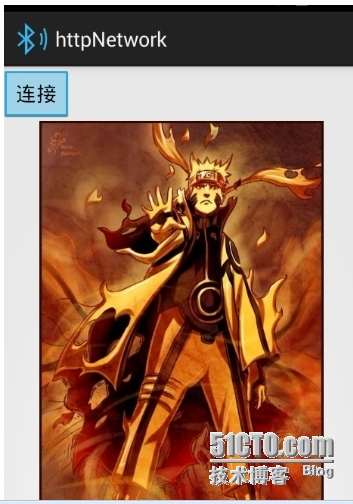android HttpClient get请求与post请求工具类
16lz
2021-01-23
今天在学习android的http通信时,在一个网上的demo中,发现了一个个人感觉比较好用的HttpClient发送get请求与post请求的工具类,所以个人把它整理与修改了一下,希望能够帮助有需要的人:
import org.apache.http.HttpEntity;import org.apache.http.HttpResponse;import org.apache.http.HttpStatus;import org.apache.http.NameValuePair;import org.apache.http.client.HttpClient;import org.apache.http.client.entity.UrlEncodedFormEntity;import org.apache.http.client.methods.HttpGet;import org.apache.http.client.methods.HttpPost;import org.apache.http.impl.client.DefaultHttpClient;import org.apache.http.message.BasicNameValuePair;import org.apache.http.util.EntityUtils;/** * HTTP通信的工具类 */public final class HttpUtil { /** 定义HTTP通信的对象 */ private static HttpClient httpClient = new DefaultHttpClient(); /** 定义基础的请求URL */ private static final String BASE_URL = "http://wenwen.soso.com/p/20120206/20120206134715-1866254203.jpg"; /** * 发送GET请求方法 * @param requestUrl 请求的URL * @return 响应的数据 */ public static InputStream sendGetRequest(String requestUrl){ /** 创建get请求对象 */ HttpGet httpGet = new HttpGet(BASE_URL + requestUrl); try { /** 执行GET请求 */ HttpResponse response = httpClient.execute(httpGet); /** 判断响应的状态码: 200代表响应成功 */ if (response.getStatusLine().getStatusCode() == HttpStatus.SC_OK){ /** 获取响应的实体 */ HttpEntity entity = response.getEntity(); /** 返回响应的数据 */ return entity.getContent(); //当需要返回为输入流InputStream时的返回值 //return EntityUtils.toString(entity); // 当返回的类型为Json数据时,调用此返回方法 } } catch (Exception e) { e.printStackTrace(); } return null; } /** * 发送post请求 * @param requestUrl 请求的URL * @param params 请求的参数 * @return 响应的数据 */ public static InputStream sendPostRequest(String requestUrl, Map<String, String> params){ /** 创建post请求对象 */ HttpPost httpPost = new HttpPost(BASE_URL + requestUrl); try { /** 设置请求参数 */ if (params != null && params.size() > 0){ /** 将map转化成list集合 */ List<NameValuePair> paramLists = new ArrayList<NameValuePair>(); for (Map.Entry<String, String> map : params.entrySet()){ paramLists.add(new BasicNameValuePair(map.getKey(), map.getValue())); } /** 为POST请设置请求参数 */ httpPost.setEntity(new UrlEncodedFormEntity(paramLists, "UTF-8")); } /** 执行post请求 */ HttpResponse response = httpClient.execute(httpPost); /** 对响应的状态做判断 */ if (response.getStatusLine().getStatusCode() == HttpStatus.SC_OK){ /** 服务器响应成功 , 获取响应实体*/ HttpEntity entity = response.getEntity(); /** 返回响应数据 */ return entity.getContent(); //当需要返回为输入流InputStream时的返回值 //return EntityUtils.toString(entity); } } catch (Exception e) { System.out.println(BASE_URL + requestUrl); e.printStackTrace(); } return null; }} 当然,基本请求Url BASE_URL 需要我们视情况而定,当我们需要的返回值类型为输入流时
return entity.getContent(); //当需要返回为输入流InputStream时的返回值
当我们需要的返回值类型为Json格式字符串时,我们返回
return EntityUtils.toString(entity); // 当返回的类型为Json数据时,调用此返回方法下面是一个调用的Demo
XML:
<LinearLayout xmlns:android="http://schemas.android.com/apk/res/android" xmlns:tools="http://schemas.android.com/tools" android:layout_width="match_parent" android:layout_height="match_parent" tools:context=".MainActivity" android:orientation="vertical" > <Button android:layout_width="wrap_content" android:layout_height="wrap_content" android:text="连接" android:onClick="check"/> <ImageView android:layout_width="match_parent" android:layout_height="wrap_content" android:id="@+id/iv"/></LinearLayout>
代码调用:
public void check(View v){ new Thread(){ public void run() { InputStream is = HttpUtil.sendGetRequest(""); Bitmap map = BitmapFactory.decodeStream(is); Message msg = Message.obtain(); msg.obj = map; handler.sendMessage(msg); }; }.start(); } private Handler handler = new Handler(){ public void handleMessage(Message msg) { iv.setScaleType(ScaleType.FIT_CENTER); iv.setImageBitmap((Bitmap) msg.obj); }; }; 效果图:
当然,本人调用的是HttpUtil.sendGetRequest("")方法,sendPostRequest()方法网络返回状态为400,估计要在项目中或者要自己建立服务器来处理Post请求才可以
更多相关文章
- Android去除系统自带动画的两种方法
- android studio中建立assets和jnilibs的方法
- android查看SQLite数据库linux命令
- adb shell 命令查看android 应用程序 创建的 sqlite 数据库
- Android unspecified' depends on one or more Android Librarie
- Android数据持久化
- android控件-ImageView使用方法整理
- android的listview 嵌套在 ViewPage 多次调用getview原因和解决
- Android提交数据到服务器的两种方式四种方法
